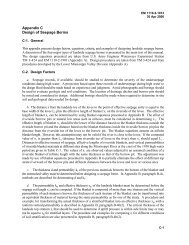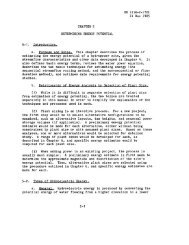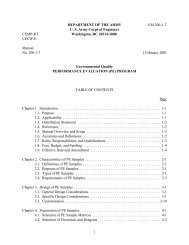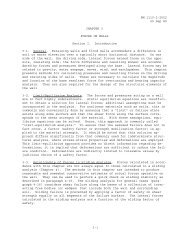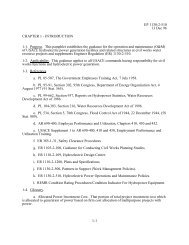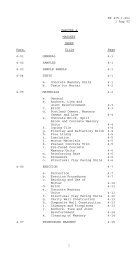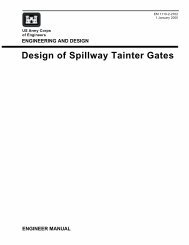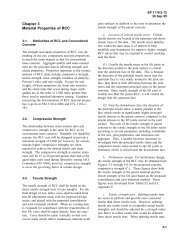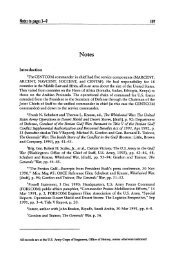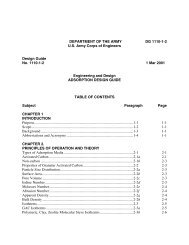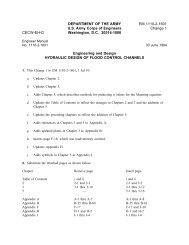Earthquake Design and Evaluation of Concrete Hydraulic Structures
Earthquake Design and Evaluation of Concrete Hydraulic Structures
Earthquake Design and Evaluation of Concrete Hydraulic Structures
Create successful ePaper yourself
Turn your PDF publications into a flip-book with our unique Google optimized e-Paper software.
EM 1110-2-6053<br />
1 May 2007<br />
topography <strong>of</strong> the site. All these factors are considered in detail in a site-specific ground motion<br />
study, rather than in a general fashion as occur in the st<strong>and</strong>ard response spectra methodology.<br />
Also, due to regional differences in some <strong>of</strong> the factors affecting earthquake ground motions,<br />
different attenuation relationships exist. There are two basic approaches to developing sitespecific<br />
response spectra: deterministic <strong>and</strong> probabilistic. In the deterministic approach,<br />
typically one or more earthquakes are specified by magnitude <strong>and</strong> location with respect to a<br />
site. Usually, the earthquake is taken as the Maximum Credible <strong>Earthquake</strong> (MCE), <strong>and</strong><br />
assumed to occur on the portion <strong>of</strong> the source closest to the site. The site ground motions are<br />
then estimated deterministically, given the magnitude <strong>and</strong> source-to-site distance. In the<br />
probabilistic approach, site ground motions are estimated for selected values <strong>of</strong> probability <strong>of</strong><br />
ground motion exceedance in a design time period or for selected values <strong>of</strong> the annual<br />
frequency or return period <strong>of</strong> ground motion exceedance. A probabilistic ground motion<br />
assessment incorporates the frequency <strong>of</strong> occurrence <strong>of</strong> earthquakes <strong>of</strong> different magnitudes on<br />
the various seismic sources, the uncertainty <strong>of</strong> the earthquake locations on the various sources,<br />
<strong>and</strong> the ground motion attenuation including its uncertainty. Guidance for developing sitespecific<br />
response spectra <strong>and</strong> for using both the deterministic approach <strong>and</strong> the probabilistic<br />
approach can be found in EM 1100-2-6050.<br />
e. Acceleration Time Histories. EM 1110-2-6051 describes the procedures for developing<br />
site-specific acceleration time-histories <strong>of</strong> ground motion for dynamic analysis <strong>of</strong> hydraulic<br />
structures. The overall objective is to develop a set (or sets) <strong>of</strong> time-histories that are<br />
representative <strong>of</strong> site ground motions that may be expected for the design earthquake(s) <strong>and</strong><br />
that are appropriate for the types <strong>of</strong> analyses planned for specific structures. The following<br />
steps are included in this process:<br />
(1) Initially selecting recorded time-histories that are reasonably consistent with the tectonic<br />
environment <strong>of</strong> the site; design earthquake (magnitude, source-to-site distance, type <strong>of</strong> faulting);<br />
local site conditions; <strong>and</strong> design ground motion characteristics (response spectral content,<br />
duration <strong>of</strong> strong shaking, <strong>and</strong> special characteristics, e.g. near-source characteristics). If<br />
sufficient recorded motions are not available, simulated recorded time-histories can be<br />
developed using ground motion modeling methods.<br />
(2) Modifying time-histories selected in (1) above to develop the final set(s) to be used in<br />
dynamic analysis. Two approaches that can be used in this process are simple scaling <strong>of</strong> timehistories<br />
(by constant factors) so that a set <strong>of</strong> time-histories has spectral values that, on<br />
average, are at the approximate level <strong>of</strong> the design response spectrum; <strong>and</strong> spectrum matching,<br />
which involves modifying the frequency content <strong>of</strong> a given time-history so that its response<br />
spectrum is a close match to the design response spectrum.<br />
(3) Further modifying the time-histories for site response effects, if the site is a soil site <strong>and</strong><br />
the time-histories have been developed for outcropping rock conditions.<br />
(4) Further modifying the time-histories for spatial variations <strong>of</strong> ground motion, if it is desired<br />
to incorporate effects <strong>of</strong> wave passage <strong>and</strong> incoherence in the ground motions that would arrive<br />
beneath a very large or long structure.<br />
f. Selection <strong>of</strong> records for deterministically defined <strong>and</strong> probabilistically defined earthquakes.<br />
Application <strong>of</strong> the above guidelines is straightforward when design earthquakes are expressed<br />
deterministically, i.e., in terms <strong>of</strong> magnitude, faulting type, <strong>and</strong> source-to-site distance.<br />
However, the application <strong>of</strong> the guidelines is less straightforward when the design earthquake<br />
ground motions (typically the response spectrum) are derived from a probabilistic ground motion<br />
3-2




